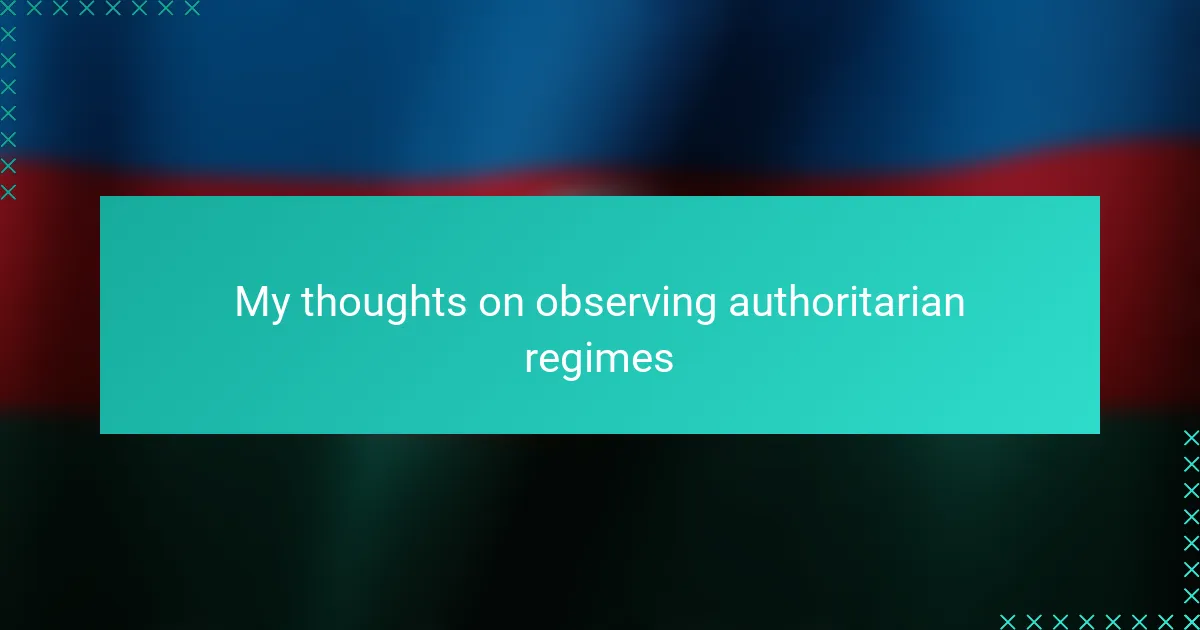Key takeaways
- Authoritarian regimes rely on centralized power, creating an atmosphere of fear that suppresses dissent and discourages trust among citizens.
- Manipulation of information, propaganda, and censorship are key tools used by such regimes to maintain control and reshape societal narratives.
- Analyzing state-controlled media, grassroots resistance, and legal shifts offers insights into the complex dynamics of authoritarianism.
- The global impact of authoritarian regimes complicates international relations and poses challenges to democratic values and resilience in open societies.
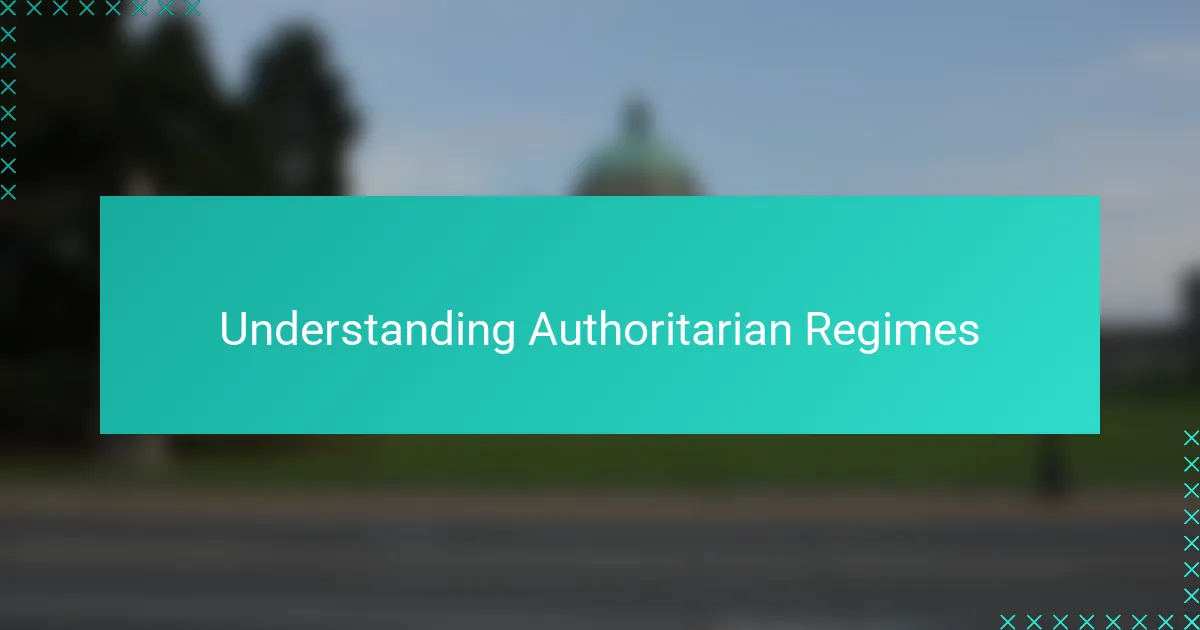
Understanding Authoritarian Regimes
Understanding authoritarian regimes requires more than just recognizing their rigid structures; it calls for seeing how they shape daily life and silence dissent. I’ve often wondered what it must feel like to live under constant watch, where every word and action could be scrutinized or even punished. This perspective brings a deeper appreciation for the courage it takes to resist such control.
From what I’ve observed, these regimes rely heavily on centralized power and limited political freedoms to maintain control. But it’s not just about laws; it’s about creating an atmosphere of fear and uncertainty that forces conformity. Have you ever thought about how this atmosphere impacts people’s trust in one another or their sense of hope?
Finally, authoritarianism often manipulates information to maintain its grip, controlling narratives to justify its actions. I find it striking how controlling the flow of information can reshape reality itself, making people question what is true or false. This manipulation isn’t just political—it becomes deeply personal, affecting how individuals perceive their own lives and futures.
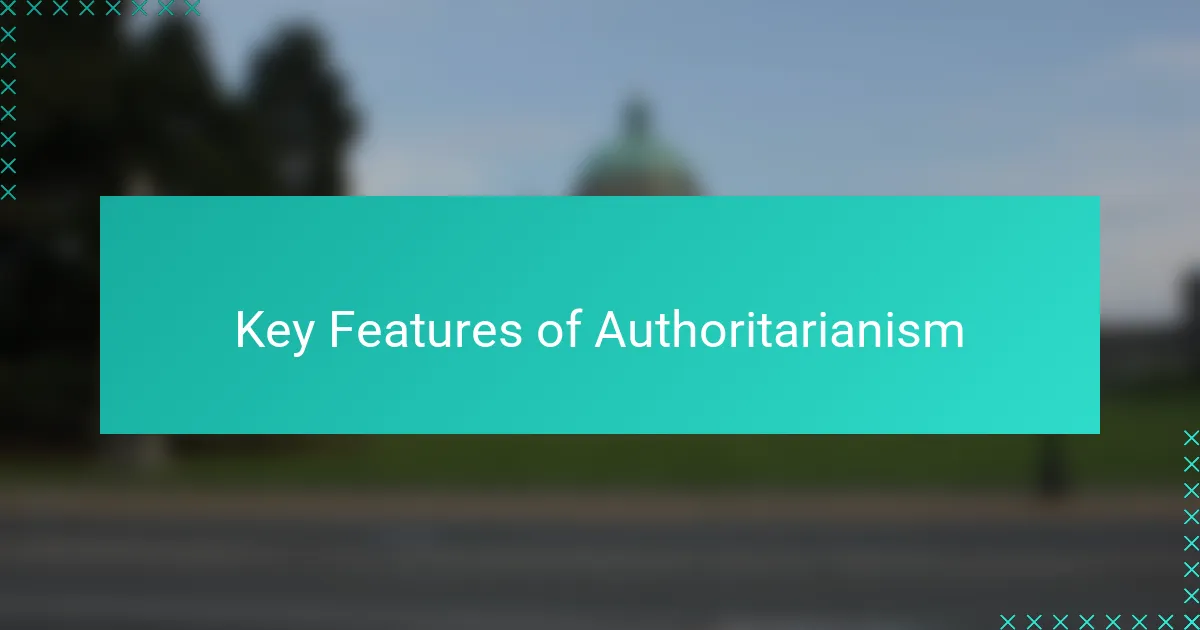
Key Features of Authoritarianism
One of the most telling features of authoritarian regimes, in my experience, is the concentration of power in the hands of a single ruler or a small elite. It’s not just about who holds office; it’s about how every decision, large or small, filters through this narrow channel, leaving little room for alternative voices. I often reflect on what that means for ordinary citizens watching from the sidelines, wondering if their opinions even matter.
Another striking feature is the systematic suppression of political opposition and dissent. I’ve read stories of neighbors disappearing after a whispered criticism or friends severing ties out of fear. This creates a chilling environment where speaking out feels like walking a tightrope without a safety net. Have you ever imagined living in a society where trust becomes a luxury too dangerous to afford?
Lastly, I find the extensive use of propaganda and censorship profoundly unsettling. Authoritarian regimes don’t just block inconvenient facts—they craft an entire reality that supports their narrative. From my perspective, this distortion doesn’t just confuse people; it isolates them, cutting them off from the collective memory and shared truth that bind societies together. How does one hold onto hope when the very story of the present is rewritten day by day?
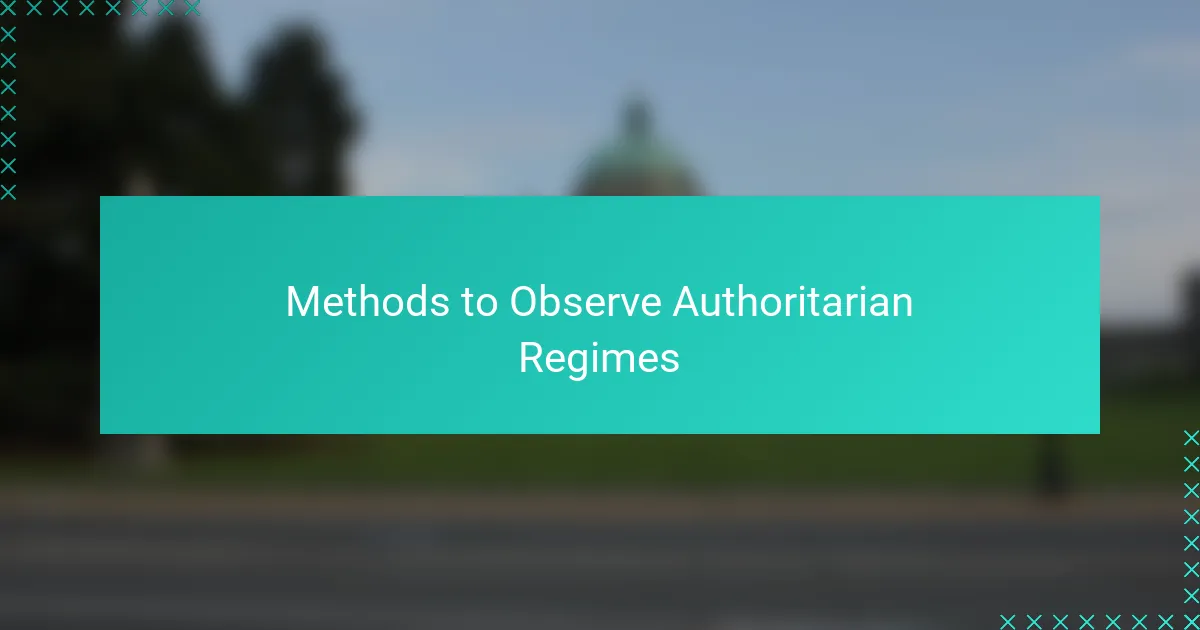
Methods to Observe Authoritarian Regimes
When observing authoritarian regimes, I’ve found that analyzing state-controlled media offers a revealing window into the narratives the regime wants to impose. Watching how information is selectively presented—or completely omitted—helps me understand not just what is being said, but what the regime fears most. Have you noticed how silence can sometimes speak louder than words in these contexts?
Another method I rely on is tracking the responses of civil society, even in the smallest forms of protest or subtle resistance. These acts, though often discreet and risky, show the undercurrents of dissatisfaction beneath the surface. It makes me wonder how much courage is required to speak out when every move is potentially dangerous.
Finally, monitoring shifts in legal frameworks and official policies can reveal how authoritarian regimes tighten or loosen their grip over time. I’ve seen how legal changes, while appearing technical, often signal deeper strategic moves to suppress opposition or co-opt support. Do these shifts hint at weakness or simply a new strategy to maintain control? Observing these subtleties keeps me engaged in trying to decode an ever-changing power landscape.

Impact on Global Politics
Authoritarian regimes don’t just reshape their own countries; their actions ripple across the global stage in ways that are both subtle and profound. I’ve noticed how these regimes often challenge international norms, pushing other nations to respond with a mix of diplomacy, sanctions, or sometimes uneasy alliances. Reflecting on this, I wonder how much the world’s stability hinges on managing these delicate relationships.
From my perspective, the presence of authoritarian regimes can create powerful blocs that disrupt global cooperation, especially on issues like trade, security, or human rights. Watching how these countries sometimes unite to resist global pressure makes me think about the complexities beyond the usual narratives of good versus bad—there’s a strategic calculation that often gets overlooked.
What strikes me most is how authoritarianism abroad impacts democracy at home; it tests the resilience of open societies facing propaganda or disinformation campaigns meant to sow discord. I often question, how prepared are we really to defend our values when authoritarian influence goes global? This interconnectedness means observing these regimes is not just an academic exercise—it’s a crucial part of understanding our own political future.
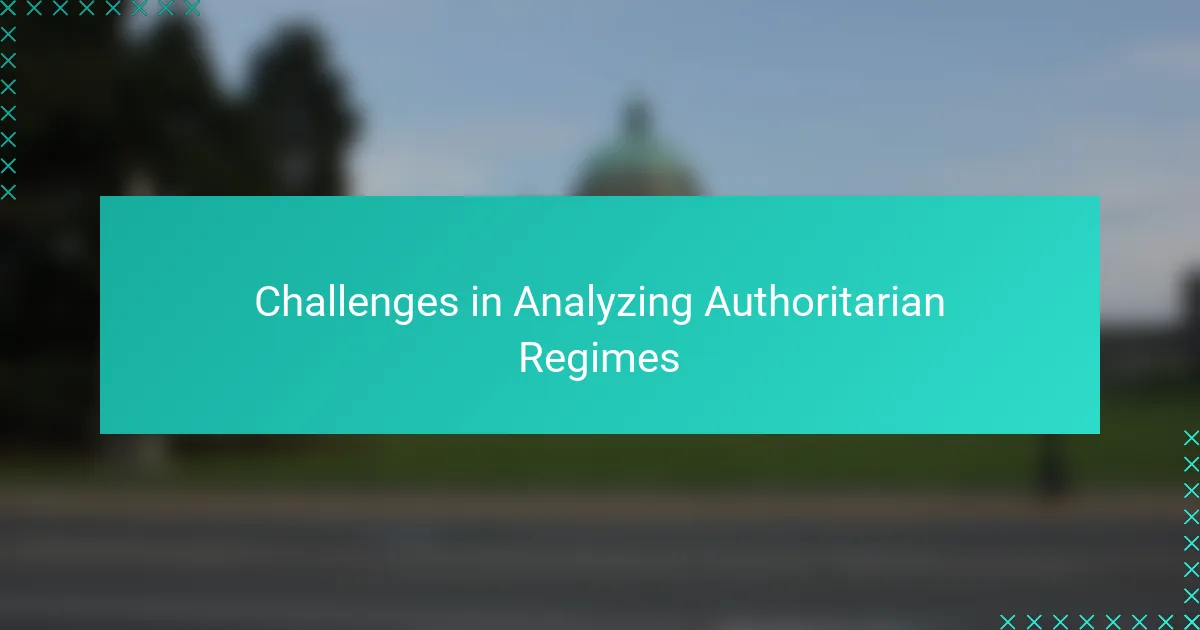
Challenges in Analyzing Authoritarian Regimes
One of the biggest hurdles I’ve faced in analyzing authoritarian regimes is just getting accurate information. When everything is filtered through a state-controlled lens, how can we be certain what’s real? It often feels like piecing together a puzzle where many of the pieces are deliberately hidden or distorted.
I also find it challenging to interpret the subtle signals beneath overt repression. Small acts of defiance can be easily missed or misunderstood without context. Have you ever tried to read between the lines when people speak in coded language, fearing for their safety? It’s a constant reminder of how cautious and nuanced such analysis must be.
Lastly, the unpredictable nature of these regimes keeps me on my toes. Shifts in policy or rhetoric might be sudden, strategic moves to intimidate rivals, or signs of internal instability. It makes me wonder—how much of what we see is performance, and how much is genuine change? This uncertainty adds a layer of complexity that few political analyses can fully capture.
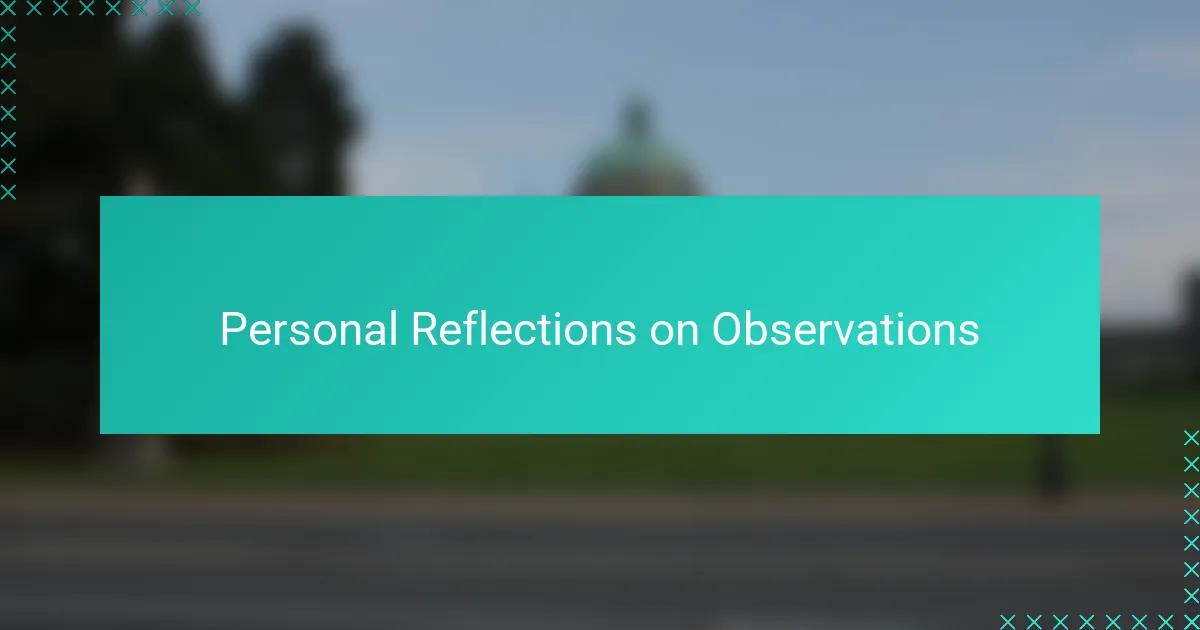
Personal Reflections on Observations
Reflecting on my observations, I often find myself wrestling with a mix of admiration and sorrow—admiration for the resilience I see in people who live under such regimes, and sorrow for the daily compromises they must make to survive. It’s hard not to feel a pang of helplessness, wondering what small acts of courage actually translate into meaningful change.
Sometimes, I catch myself questioning how much we, as outsiders, truly grasp about life behind the curtain of authoritarian control. Does analyzing reports and statistics ever capture the quiet moments of fear or hope? From my experience, it’s in those personal stories where the real impact emerges, reminding me that behind political structures are human lives shaped in profound ways.
At times, observing how fear permeates even casual conversations strikes me deeply. I’ve noticed how silence becomes a form of self-preservation, a barrier against the invasive gaze of the regime. It makes me ask, what does it take to reclaim one’s voice when speaking out carries such risk? This question stays with me long after the data is analyzed or the headlines are read.

Practical Insights for Political Analysis
When I analyze authoritarian regimes, I find it crucial to ground observations in concrete, verifiable events rather than broad assumptions. For example, noticing shifts in public speeches or sudden legal announcements often signals a strategic move before it becomes obvious. Have you ever caught yourself spotting these subtle cues, realizing that what the regime says or doesn’t say is just as important as their actions?
Looking at grassroots responses adds another layer to political analysis. In some cases, small acts of resistance—like clandestine art or coded messages—reveal tensions hidden beneath a façade of control. From my experience, tuning into these undercurrents requires a patient and empathetic lens, because the most telling signs are rarely loud or public.
Finally, I can’t stress enough how cross-referencing multiple sources deepens the understanding of authoritarian dynamics. Sometimes official narratives and independent reports clash dramatically, and piecing them together feels like assembling a puzzle with constantly shifting fragments. Do you think political analysts can ever claim full clarity in such a murky environment? I’m convinced that embracing uncertainty is not a weakness but a vital part of pragmatic political insight.
